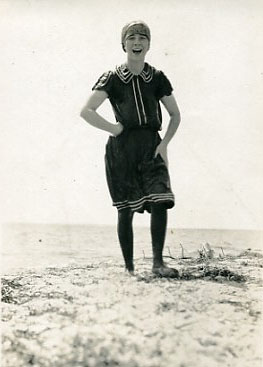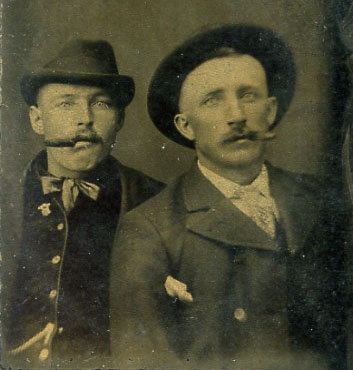Or dream those dreams again..."
-- Charlotte Barnard

Photographer unknown, 1912, from "Some Introductory Remarks on the History of Summer (1900-1919)"
One of the most surprising things about old photos is how alien they can look. Human beings haven’t changed in any basic way since deep in our prehistory, yet a photographed face from our own parents’ time can sometimes seem to stare at us across an immeasurable gulf of time. Unfamiliar formats & posing conventions, not to mention changed clothing & hair styles, public & private furnishings and of course technology – encourage this dislocation. But in fact these changes only signal a simple truth – that the whole universe changes utterly, irrevocably, molecule by molecule, second by second. There is no going back.

Photographer unknown, "The Portrait Gallery"
One way to connect with an old photograph, I’ve found, is to look at it for a long time. If a glimpse doesn’t yield familiarity, hang around a while. It’s like coming out of a hotel onto the busy street of a strange town. The 1st time you’re a stranger, but by the third or fourth you know what side of the street gets the afternoon sun, a good place to eat, where to buy a paper, find a late-night ATM & so on. It’s not that you’re any more fully there. It’s that now you can imagine yourself there.
Square America: “A gallery of vintage snapshots and vernacular photography,” from which the pictures above are taken, covers the first 75 years of the 20th century. “Not only do these photographs contain a wealth of primary source material on how life was lived, they also constitute a shadow history of photography…” says the collector/curator in a brief “about” section (unsigned, like most of the snapshots). As organized on the site, they’re also brilliant "outsider" art. My favorite sections are:
Some Introductory Remarks on the History of Summer (1900-1960)
The Portrait Gallery
And here are a couple of superb collections by two friends of mine. Highly recommended.
Andrew Long is a photographer and writer who edits The Daily Flog. His well-chosen collection of vintage photos is here.
Nancy Fulton has collected & written movingly about pictures of her family here.
8 comments:
wow, thanks Tim!
But damn! I found that site recently too, and was going to blog about the Summer group on Memorial Day! Oh well, the hazards of blogging.
Andrew, Oh dear...but why shouldn't you go ahead? Mine is in no way tied to the summer hook you contemplate. The history of summer is only one of many galleries the guy has made, as you know. I'm talking about old photos in general & Squareamerica in toto, but you could focus on just the summer pix.
Also it's 2+ weeks off & anyway nobody reads this blog (sniff).
You may recall several years ago when I showed some of my photographs to a noted museum photography curator. Among his advice was not just to spend a lot of time looking at pictures, but to study the history of photographs. I immediate went out and bought a copy of John Szarkowski's "Looking at Photographs," which did open my eyes to a lot of what was going on that I hadn't noticed before.
You might also enjoy "Disfarmer" (Vintage Press), a collection of everyday studio photographs all from the collection of one small town photographer who lived and worked in the little town of Heber Springs, Arkansas, during the years between the Depression and WWII. He's frequently compared to August Sander, though his subjects are far more quotidian.
Your comments also reminded me of the time, just a few years ago, when I saw a very early color photograph of a group of French WWI soldiers. Because history is so often visually presented in drawings and photographs in b&w, which for me equals not just historical distance but also a screen of almost make-believe, I wasn't convinced this wasn't just some reenactment until I read up on the process. The images made those soldiers incredibly real, and forever changed the way I think about WWI (which, truth be told, I don't think about very much). No longer were people of that time relegated to the pace of hand-cranked motion film cameras. The soldiers in those photographs were as real and alive as we are today.
Chris, One of the things I get from Disfarmer's portraits is a certain discomfort & wariness, which becomes a style. I mean awkwardness can reveal as much as comfort (Avedon shows that in some of his pictures). Disfarmer's sitters (mostly standers) were in an unfamiliar place, often wearing their Sunday best. I doubt they were that awkward back at the farm.
Amazing about that WWI picture. You speak of August Sander. I saw some of his prints at the recent AIPAD show & had the same sensation you describe-- looking through time at people "real and alive as we are today." To me, though, they are very unlike Disfarmer's portraits. What's striking is how totally self-possesed they are; each person photographed seems to fully imhabit him or her self at the moment of exposure. Maybe that's a German thing -- deep identification with one's trade or profession -- & Sander also poses them in their place of work or at least with their tools & in their work clothes. Or maybe it's some thing a genius like Sander does to make a portrait. Anyway, strange & different as they were in many respects, I felt no distance at all in human terms.
I stumbled on this today, probably everyone else has already seen it:
http://www.vanityfair.com/magazine/2006/12/yearinphotos_portfolio200612?slide=1
I was intrigued that so many of the photographs I liked turned out to be Annie Liebowitz (of whom I had never heard until I read your review).
Sylvia, No, I hadn't seen it. Thanks. I agree about Liebovitz. She's really good at what she does, isn't she? Love the way so many of her portraits are stories -- fantasies really. The subject is the same size as 5 or 6 other people & needs to be made the star by costume, lighting, placement & storytelling.
Agree with you completely about the Disfarmer portraits. Everyone looks a little uneasy, like they're embarrassed to think we might think they're vain to have had images of themselves made during such tough times.
As for the Sander portraits, I can't remember whether it's something I read about them or just my own interpretation. But I've always perceived their confident poses as a desire to re-create the same look and feel they would have desired in a painted portrait.
Interestingly, I still find that happening a lot when my travels cross paths with Indian families. Instead of the hasty snapshots most American families take, the Indian patriarch will clear the wife and kids from view and strike a Napoleonic pose that doesnt' just saw "Look where I was," but also says "Look at who I am."
Chris, Thanks for the insight about the Arkansan farmers & their instinctive fear of appearing vain. That was my parents' way too. "Don't get too full of yourself" & "The greatest sin is pride."
Yes, I bet you're right about Sander's subjects too. I imagine in Sander's time with its pride in progress, expressed in machines, the rising trade & middle class would have seen photography -- at least as practiced by someone like Sander -- as equal in status & importance to a small painted portrait.
Post a Comment